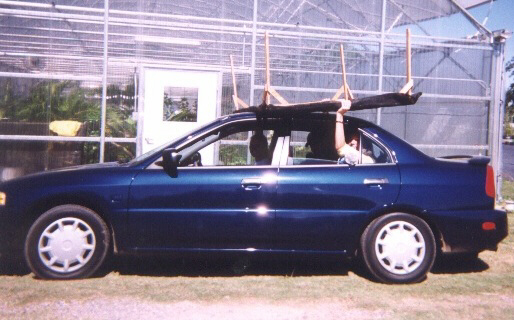Results
After allowing the turf to grow for three weeks, we obtained the following
data:
Height (inches)
| |
A
|
B
|
C
|
| |
sun |
shade |
sun |
shade |
sun |
shade |
| Average |
2.64 |
4.60 |
4.13 |
5.60 |
3.42 |
3.83 |
| Tallest |
3.50 |
5.75 |
6.00 |
7.75 |
5.00 |
5.50 |
| No. over 3" |
7 |
12 |
10 |
12 |
8 |
10 |
Spread (inches)
| |
A
|
B
|
C
|
| |
sun |
shade |
sun |
shade |
sun |
shade |
| Least |
0 |
0 |
0 |
0 |
0 |
0 |
| Greatest |
4.0 |
4.0 |
4.0 |
4.5 |
3.5 |
3.0 |
Health (ranked - higher is better)
| |
A
|
B
|
C
|
| Survival Rate |
1 |
1 |
2 |
| Color |
1 |
2 |
3 |
| Thickness |
2 |
1 |
3 |
| Thatch level |
1 |
3 |
2 |
| Overall Rating |
1 |
2 |
3 |
Summary of Results
The Centipedegrass was by far the worst performer among the three. It did
not seem to handle being transplanted well at all. After the transplant,
it showed minimal growth and diminishing health. Aesthetically, it proved
to be the worst-looking of the three. It was brown and thin with a significant
amount of thatch.
The Bermudagrass handled the transplant the best of the three. It showed
the greatest amount of growth and recovered its color the quickest. However,
the amount of thatch present eventually overtook the amount of actual living
grass. Though it spread farther than the others, most of this area was
comprised of thatch.
The St. Augustine grass, though slow to recover from the transplant,
showed the best longevity and ended up as the healthiest of the three.
Though taking a longer time to return to its natural green, it was the
most aesthetically pleasing when healthy. Based on our observations, the
St. Augustine grass showed the most promise for overall health, growth,
and appearance had the experiment been continued for a longer period of
time.
Recommendations
Although the soil test results were not directly used in our experiment,
they showed an extremely low organic matter content (on the average of
0.25%) and a neutral pH (on the average of 7.15). Based on these results,
the Greens should add a significant amount of organic matter before planting
any kind of turf on their property.
For turf growth maximization, Centipedegrass would not be recommended
at all. If immediate results are desired, the strong initial growth rate
of Bermudagrass would be well-suited to this end. However, our recommendation
is to invest the time that St. Augustine requires. This will produce a
higher-quality, more aesthetically pleasing lawn that should outlast the
test of time.
And finally...
Special thanks goes out to:
-
The Agronomy department for the use of the greenhouse and other supplies
-
Bob and the Horticulture department for the pots, tags, shade cloth, and
good advice
-
Daniel and Burden for the turf
-
Mark and Steven for the help and encouragement they offered
-
Paul for the design of this webpage
Thanks everyone!!!


